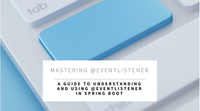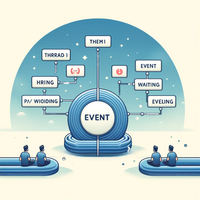Explore web search results related to this domain and discover relevant information.
... You derive from the listbox, ... manipulates other things on your parent form. With events: Your form listens for the event to indicate a user selected something, and manipulates other things on the form....
Find centralized, trusted content and collaborate around the technologies you use most. Learn more about Collectives ... Connect and share knowledge within a single location that is structured and easy to search. Learn more about Teams · Get early access and see previews of new features. Learn more about Labs ... I'm understanding how events work in C# (am a fair newbie in this field).When the user selects something from the listbox, you want to know, and modify other things on the form. ... You derive from the listbox, overriding things to make sure that your parent is the form you expect to be on. You override a ListSelected method or something, that manipulates other things on your parent form. With events: Your form listens for the event to indicate a user selected something, and manipulates other things on the form.The difference being that in the without events case you've created a single-purpose class, and also one that is tightly bound to the environment it expects to be in. In the with events case, the code that manipulates your form is localized into your form, and the listbox is just, well, a listbox. ... What would be very useful is a non trivial example of an app which uses events (guess it really helps testing too?)You could always build your own way of sending/receiving events, subscribing/unsubscribing to event sources. But the language gives you a simple/standard way of doing it, so that is a good reason to use language "events" instead of your own events technique.

City ordinance prohibits on-street parking in three residential areas only during certain AT&T Stadium events.

Inline handlers: Inline JavaScript to be executed when the event is triggered (similar to the native onclick attribute). Method handlers: A property name or path that points to a method defined on the component. Inline handlers are typically used in simple cases, for example:
Do not use .passive and .prevent together, because .passive already indicates to the browser that you do not intend to prevent the event's default behavior, and you will likely see a warning from the browser if you do so.When listening for keyboard events, we often need to check for specific keys. Vue allows adding key modifiers for v-on or @ when listening for key events: ... You can directly use any valid key names exposed via KeyboardEvent.key as modifiers by converting them to kebab-case.In the above example, the handler will only be called if $event.key is equal to 'PageDown'. Vue provides aliases for the most commonly used keys:Note that modifier keys are different from regular keys and when used with keyup events, they have to be pressed when the event is emitted. In other words, keyup.ctrl will only trigger if you release a key while holding down ctrl.

Call this method when you've used an event. The event's type will be set to EventType.Used, causing other GUI elements to ignore it. Events of type EventType.Repaint and EventType.Layout should not be used. Attempting to call this method on such events will issue a warning.
Use this event.The following example demonstrates how events are consumed and used up.The following example demonstrates how handles such as Handles.PositionHandle and Handles.FreeMoveHandle might use events.Event.current.Use(); } // This if statement does not check Event.current.button, but it only triggers // when Event.current.button is not 0 because the previous if statement will // Use up the MouseDown event if it is.


Learn more about adding marketing events to your HubSpot account to analyze marketing activities.
Customer Blog Examples of how real customers use HubSpot for their business. Product Updates Blog Updates on the latest releases from HubSpot’s Product team. ... HubSpot can aggregate marketing events from certain connected apps, so you can have a consistent overview of your marketing events.The Lists section shows all lists created with marketing event filters specific to the event. Click the name of each list to view it. · Please note: for registrations, HubSpot will always count each registration, even if a registration occurred and was then cancelled. · In Marketing Hub Enterprise accounts, you can also use registration data from your marketing events in an attribution report.If you are a marketer or event manager, and you need to analyze and report on the performance and engagement of your marketing events, you can create a custom report using Marketing event analytics, Marketing event participation, or Marketing events as your primary data source. Learn more about creating a custom report. ... Thank you for your feedback, it means a lot to us. This form is used for documentation feedback only.To track marketing events in your revenue attribution reports you can use the interaction types Attended marketing event, Registered for a marketing event and Media played.
Events are things that happen in the system you are programming, which the system tells you about so your code can react to them. For example, if the user clicks a button on a webpage, you might want to react to that action by displaying an information box. In this article, we discuss some ...
Events are things that happen in the system you are programming, which the system tells you about so your code can react to them. For example, if the user clicks a button on a webpage, you might want to react to that action by displaying an information box. In this article, we discuss some important concepts surrounding events, and look at the fundamentals of how they work in browsers.Events are fired inside the browser window, and tend to be attached to a specific item that resides in it. This might be a single element, a set of elements, the HTML document loaded in the current tab, or the entire browser window. There are many different types of events that can occur. ... The user selects, clicks, or hovers the cursor over a certain element.The user presses a key on the keyboard. ... A web page finishes loading. A form is submitted. A video is played, paused, or ends. ... You can gather from this (and from glancing at the event index) that there are a lot of events that can be fired.These are often used to display information about filling in form fields when they are focused, or to display an error message if a form field is filled with an incorrect value. dblclick — The color changes only when the button is double-clicked. mouseover and mouseout — The color changes when the mouse pointer hovers over the button, or when the pointer moves off the button, respectively. Some events, such as click, are available on nearly any element.

In these kind of situations you ... There are number of events that works for only the Pull Request given in the table below. ... If we want our workflow run to initiate when the activity type is of Assigned and Unassigned then in that case we can use the “types” keyword ...
In these kind of situations you can specify which activity type for the event will trigger the workflow run, which will give us more granular control over exactly how and when we want our workflow to be triggered from an event. There are number of events that works for only the Pull Request given in the table below. ... If we want our workflow run to initiate when the activity type is of Assigned and Unassigned then in that case we can use the “types” keyword under our event.In external events we can use the Github APIs to trigger a webhook events called repository_dispatch, when you want to trigger the activities that happens outside the Github.In order to achieve through external events we need to send the request to Github API endpoint, then provide an event type to describe the activity you want.To trigger the workflow run in yml file, you need to configure your workflow to use repository_dispatch event.GitHub Events An event is a specific activity in a repository that triggers a workflow run. We can configure our workflows to run when specific activity on GitHub happens, such as commits, Pull …
This is the first time I interact heavily with Unity’s GUI events. I’m confused about the ‘Use’ method. The doc says: Call this method when you’ve used an event. The event’s type will be set to EventType.Used, causing other GUI elements to ignore it.
I’m writing a node-based editor. This is the first time I interact heavily with Unity’s GUI events. I’m confused about the ‘Use’ method. The doc says: Call this method when you’ve used an event. The event’s type will be set to EventType.Used, causing other GUI elements to ignore it.I’m writing a node-based editor. This is the first time I interact heavily with Unity’s GUI events. I’m confused about the ‘Use’ method. The doc says: Call this method when you’ve used an event. The event’s type will …


JavaScript events are the backbone of making modern websites interactive. They allow developers to capture user actions like clicking a button, scrolling through a page, or submitting a form. Mastering event handling is key to creating responsive web applications that enhance user experience.
In this post, we’ll dive into JavaScript events — what they are, how to use them, and why they’re crucial for modern web development. You’ll learn the different types of events, how to capture them, and best practices for handling user actions.These events are actions or occurrences — like clicking a button, typing into a form, or resizing a window — that happen in the browser and are detected by JavaScript. By responding to these events, you can create dynamic websites that provide instant feedback to users.In JavaScript, events can be triggered by both users and the browser itself. For example, a user may trigger a mouse event by clicking on a button, or the browser might trigger a window event when a page finishes loading.Without event handling, websites would function as static documents where every interaction requires a full page reload — much like the web of the late 90s. By learning how to handle events in JavaScript, you can dramatically enhance the user experience, making your web applications more fluid and engaging.
You should trigger the page visit events when a user visits the respective type of page in the application. The default page visit events include the Homepage View, Listing Page View, Product Detail Page View, Cart Page View, and Confirmation Page View.
This method allows you to tag the visits on your listing page as an event. You can call this method each time a user visits your listing page along with the following event parameters: taxonomy, type, referrer, key, show_on_segment, is_pii, device_type, url, and source.This method allows you to tag the visits on your product page as an event. You can call this method each time a user visits your product page along with the following event parameters: product ID, name, taxonomy, imageURL, price, and currency.This method allows you to tag the visits on your cart page as an event. You can call this method each time a user visits your cart page along with the following event parameters: product ID, name, taxonomy, imageURL, price, and currency.This method allows you to tag the visits on your wishlist page as an event. You can call this method each time a user visits your wishlist page along with the following event parameters: product ID, name, taxonomy, imageURL, price, and currency.

In this feature, agency correspondent Heather Nicholls speaks to Jade Ball, head of events at BI Worldwide about how data is increasingly being used in events and whether it is here to stay or just a passing trend.
This is always supplemented by personalised verbatim feedback to ensure that all feedback is taken into consideration in the post-event analysis. It is vital that agencies are transparent with their clients around the collection and use of data but the area that can be challenging is around delegates understanding of the use of data.As data becomes more incorporated into the world of events, Ball has found that clients are starting to ask for more granular performance metrics from events. For example, satisfaction scores – which were previously used as a measure of event success, are being phased out in favour of questions that are linked back to the objectives with a focus on future improvements.It is likely that delegates will become more aware of the risks of their data being used elsewhere, so stringent security measures will need to be put in place to ensure that data isn’t subjected to · Ball says: “Data is here to stay. The insights it provides can affect meaningful changes to events and provide a depth of understanding that was previously impossible to achieve.The modern-day event uses data at every stage of the process. From planning right through to logistics and delivery, data helps to inform, shape and report on success, failure and progress.

The @EventListener annotation in Spring Framework is used to handle events in an application. This can be applied to methods in any Spring-managed component to listen for specific application events…
The @EventListener annotation in Spring Framework is used to handle events in an application. This can be applied to methods in any…It is part of the Spring event-driven programming model, which promotes loose coupling between components. You can leverage @EventListener to react to certain actions or changes within your application, such as a user registration, order placement, or application startup.Asynchronous Handling: Can be combined with @Async for non-blocking event processing. Conditional Listening: Use SpEL (Spring Expression Language) with condition attribute to listen based on conditions.Handles Custom and Built-In Events: Works with predefined Spring events (ContextRefreshedEvent, ApplicationReadyEvent, etc.) or user-defined events.

By understanding and using events effectively, you can implement powerful design patterns like the observer pattern and streamline interaction between components in your C# projects. Practice with similar scenarios to master the use of events and unlock their full potential in your applications.
Events in C# are a powerful mechanism for implementing the observer design pattern, facilitating communication between objects in a loosely…Understanding Events in C# with Practical Examples Events in C# are a powerful mechanism for implementing the observer design pattern, facilitating communication between objects in a loosely coupled …Events in C# are a powerful mechanism for implementing the observer design pattern, facilitating communication between objects in a loosely coupled manner. They are based on delegates and provide a way for one class (the publisher) to notify other classes (subscribers or listeners) when something of interest happens.Observer Pattern: Events are essential for implementing the observer pattern, where an object (the subject or publisher) maintains a list of dependents (observers or subscribers) that are notified of state changes.

Custom events are user-defined events that can be created and dispatched to signal that something has happened in your application. They allow you to decouple different parts of your application, making it more modular and maintainable.
The CustomEvent constructor allows you to create custom events that can be dispatched and listened to within your application. This is particularly useful for signaling that something specific has happened, which other parts of your application can respond to.In one of my projects, we implemented a microfrontend architecture where the parent application renders the header and side navigation (sidenav). The sidenav holds the menus for various child applications. Since the child applications do not have direct control over the sidenav click events, we used custom events to manage this interaction.Custom events in JavaScript offer a flexible and efficient way to handle interactions within your application. They are especially useful in complex setups like microfrontends, where different parts of the application need to communicate without being tightly connected.By using custom events, you can create applications that are more modular, easier to maintain, and more interactive. I hope this article helps you understand the power and usefulness of custom events in JavaScript.

Events are great. We, as JavaScript developers, use them constantly when creating and improving websites and web applications. They are an essential part of JavaScript and are necessary to a developer wanting to create any type of smooth and successful UX.
Unfortunately, this is not what this post is about and I won’t be covering that part of event listeners, but this is definitely something every JavaScript developer should know perfectly (I recommend you read more about it here ). 2. event handlers: These can be used to register to the same events as event listeners, but in a different and less powerful way.The project can be found on github and can be used as an npm package as well. Hope this article and the map help shed some light on the variety of events in JavaScript and helps us understand and explore them a little bit better.We, as JavaScript developers, use them constantly when creating and improving websites and web applications. They are an essential part of JavaScript and are necessary to a developer wanting to…How to list every javascript event in any browser, and what did I do with it
That documentation contains more detailed, developer-targeted descriptions, with conceptual overviews, definitions of terms, workarounds, and working code examples. Copyright © 1993, 2025, Oracle and/or its affiliates. All rights reserved. Use is subject to license terms.

In Python, events are a way to facilitate communication and synchronization between threads. The threading module provides the Event class, which manages an internal flag that threads can use to signal occurrences and coordinate their activities.
Events allow one thread to signal an occurrence (an event) to other threads. This is particularly useful for synchronizing actions across multiple threads.Here’s an example demonstrating how to use the Event class:Events in Python In Python, events are a way to facilitate communication and synchronization between threads. The threading module provides the Event class, which manages an internal flag that …In Python, events are a way to facilitate communication and synchronization between threads. The threading module provides the Event class…
Beamr stated that its goal is to address the common challenge in live streaming, where original footage, often recorded in formats like 720p, fails to meet the quality expectations of viewers using 4K displays.
A Stocktwits user lauded the company’s latest move. The company stated its goal is to address the common challenge in live streaming, where original footage, often recorded in formats like 720p, fails to meet the quality expectations of viewers using 4K displays. “Broadcasters and streamers have long faced the dilemma of balancing premium quality with cost efficiency for live events,” said Beamr CEO Sharon Carmel.HomeNewsMarketsEquityBeamr To Use Nvidia’s Tech To Bring Live Events Into 4K: Retail Excitement SurgesBeamr Imaging (BMR) on Monday announced plans to unveil a real-time AI solution that enhances video quality to 4K resolution for live streaming applications, especially for broadcasters and platforms covering live events such as sports and concerts.

Partner Ahren Hsu-Hoffman will speak at the Silicon Valley chapter event for the Licensing Executives Society, which will explore the intersection of copyright law, artificial intelligence (AI) innovation, and fair use.
Home > Our Thinking > Events > Copyright, Fair Use, and AI: The Current State of the LawThe panel will provide timely insights into headline-making cases and how these rulings could reshape development, use, and licensing of AI tools.

A boolean value indicating whether events of this type will be dispatched to the registered listener before being dispatched to any EventTarget beneath it in the DOM tree. Events that are bubbling upward through the tree will not trigger a listener designated to use capture.
A Firefox (Gecko)-specific parameter. If true, the listener receives synthetic events dispatched by web content (the default is false for browser chrome and true for regular web pages). This parameter is useful for code found in add-ons, as well as the browser itself.In the first case above, a new (anonymous) handler function is created with each iteration of the loop. In the second case, the same previously declared function is used as an event handler, which results in smaller memory consumption because there is only one handler function created.Since it can't be canceled, event listeners can't block page rendering anyway. See Improving scroll performance using passive listeners for an example showing the effect of passive listeners. This example demonstrates how to use addEventListener() to watch for mouse clicks on an element.In the example above, we modify the code in the previous example such that after the second row's content changes to "three", we call abort() from the AbortController we passed to the addEventListener() call. That results in the value remaining as "three" forever because we no longer have any code listening for a click event. Here, we'll take a look at how to use an anonymous function to pass parameters into the event listener.





